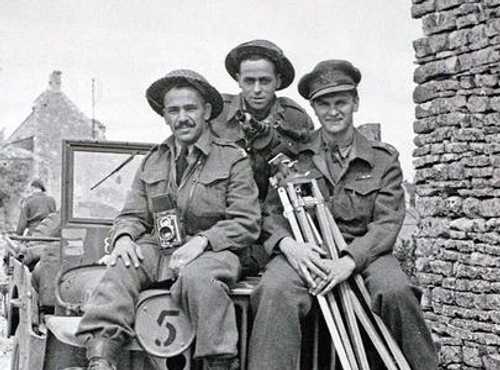
Canadian Forces
Chuck Ross and his film unit
gsellars
Chuck Ross, centre, is seen with Canadian Army Film and Photo Unit members in an undated photo from World War II. The team used a Bell & Howell 35-mm movie camera to bring back war images from the front. Through the viewfinder of a Bell & Howell 35-mm movie camera, Chuck Ross and his buddies in the army film corps brought World War II home to Canadians. They risked their lives – and some died – bringing to the big screen back home images of Canadian soldiers clawing their way across Italy, Normandy, France, Holland and Germany. "We were right there. It's the only way you can do it. ... I'm only one of many and all the boys did a great job," Ross told the Star. The unit will always carry with pride the fact the footage showing Canadians landing on Juno Beach on D-Day was later shown in the United States because the Americans lost their film canisters in the sea. "(Canadian cameraman) Bill Grant scooped D-Day. A (U.S.) colonel was taking a kit bag back to the U.K. to get processed and ... dropped the bag in the channel. ... They used our footage 48 hours later in New York and said that it was American troops. It wasn't; they were Canadians, the Queen's Own Rifles of Canada Ross said. Even now, at 89, Ross is rather nimble. It's not hard to imagine him scrambling over rubble with his tripod and movie camera or hightailing it across open ground. "I had great admiration for the infantry. They were there all the time," said Ross. Ross enlisted in Calgary on Feb. 15, 1940, in the Royal Canadian Army Service Corps and wouldn't see home again for 6 1/2 years. As luck would have it, once he got to London and did a stint ferrying vehicles around, he was seconded to the Canadian Army Film and Photo Unit. He landed in Normandy on D-Day plus nine. "You saw bodies," he recalled. The image of bloated bodies on the beach of Normandy is seared into his memory forever, but the horror "really hit home" when three members of the film and photo unit were killed. One of Ross's prize possessions is a photo of him with his movie camera trained on Field Marshal Bernard Montgomery after the Allied forces liberated Caen, France, in 1944. That was his first assignment. After France, Ross was sent to cover the Long-Toms (88-mm guns) firing on the Scheldt and the Walcheren Islands in Holland. "The Dutch didn't have anything in the way of food supply. They were actually close to starvation (when liberated by Allied troops)," recalled Ross, who later in life lost his hearing because of the pounding of the big guns, as well as a lung to pneumonia due to inclement conditions. Ross volunteered to join the Pacific invasion force but was sent to the occupation in Germany where he captured footage of the notorious S.S. Gen. Kurt Meyer as he arrived at the airport in Aurich, Germany, awaiting trial for assassinating Canadian prisoners of war.
4239 Views
11/11/2009
